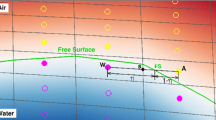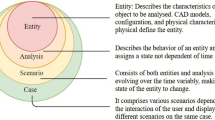Abstract
In this paper we focus on a class of applications involving surface vessels moving at high speeds, or “planing”. We introduce a Fridsma planing hull benchmark problem, and simulate it using the finite-element-based ALE-VMS (Bazilevs et al. in Math Models Methods Appl Sci 2012; Takizawa et al. in Arch Comput Methods Eng 19: 171–225, 2012) approach. The major reasons for selecting this problem is the relative simplicity of the hull geometry and the existence of high-quality experimental data used for the purposes of validation. The ALE-VMS approach is formulated in the context of the Mixed Interface-Tracking/Interface-Capturing Technique (MITICT) (Tezduyar in Arch Comput Methods Eng 8:83–130, 2001; Akin et al. in Comput Fluids 36:2–11, 2007; Cruchaga et al. in Int J Numer Methods Fluids 54:1021–1031, 2007), where the level set technique is used for capturing the air–water interface, and the Arbitrary Lagrangian Eulerian (ALE) method is employed to track the interface between the fluid and structure. In this work, the planing hull structure is treated as a six-degree-of-freedom rigid object. The computational results obtained for the Fridsma hull, which include convergence of the trim angle and drag under mesh refinement, match well with the experimental data.
Similar content being viewed by others
References
Fridsma G (1968) A systematic study of the rough-water performance of planing boats. Davidson Laboratory Report 1275
Savitsky D, Brown PW (1976) Procedures for hydrodynamics evaluation of planing hulls in smooth and rough water. Mar Technol 13: 381–400
Sun H, Faltinsen O (2007) The influence of gravity on the performance of planing vessels in calm water. J Eng Math 58: 91–107
Garme K, Rosén A (2006) Time-domain simulations and full-scale trials on planing craft in waves. J Int Shipbuilding Progress 50: 177–208
Sun H, Faltinsen O (2011) Predictions of porpoising inception for planing vessels. J Mar Sci Technol 16: 270–282
Bazilevs Y, Hsu M-C, Takizawa K, Tezduyar TE (2012) ALE-VMS and ST-VMS methods for computer modeling of wind-turbine rotor aerodynamics and fluid–structure interaction. Math Models Methods Appl Sci. Accepted for publication. doi:10.1142/S0218202512300025
Takizawa K, Bazilevs Y, Tezduyar TE (2012) Space–time and ALE-VMS techniques for patient-specific cardiovascular fluid–structure interaction modeling. Arch Comput Methods Eng 19: 171–225
Akkerman I, Bazilevs Y, Benson DJ, Farthing CE, Kees MW (2012) Free-surface flow and fluid–object interaction modeling with emphasis on ship hydrodynamics. J Appl Mech 79(1): 010909
Tezduyar TE (2001) Finite element methods for flow problems with moving boundaries and interfaces. Arch Comput Methods Eng 8: 83–130
Akin JE, Tezduyar TE, Ungor M (2007) Computation of flow problems with the mixed interface-tracking/interface-capturing technique (MITICT). Comput Fluids 36: 2–11
Cruchaga MA, Celentano DJ, Tezduyar TE (2007) A numerical model based on the mixed interface-tracking/interface-capturing technique (MITICT) for flows with fluid–solid and fluid–fluid interfaces. Int J Numer Methods Fluids 54: 1021–1031
Hughes TJR, Liu WK, Zimmermann TK (1981) Lagrangian- Eulerian finite element formulation for incompressible viscous flows. Comput Methods Appl Mech Eng 29: 329–349
Takizawa K, Tanizawa K, Yabe T, Tezduyar TE (2007) Ship hydrodynamics computations with the CIP method based on adaptive soroban grids. Int J Numer Methods Fluids 54: 1011–1019
Tezduyar TE, Behr M, Liou J (1992) A new strategy for finite element computations involving moving boundaries and interfaces—the deforming-spatial-domain/space–time procedure: I. The concept and the preliminary numerical tests. Comput Methods Appl Mech Eng 94(3): 339–351
Tezduyar TE, Behr M, Mittal S, Liou J (1992) A new strategy for finite element computations involving moving boundaries and interfaces—the deforming-spatial-domain/space–time procedure: II. Computation of free-surface flows, two-liquid flows, and flows with drifting cylinders. Comput Methods Appl Mech Eng 94(3): 353–371
Tezduyar TE (2003) Computation of moving boundaries and interfaces and stabilization parameters. Int J Numer Methods Fluids 43: 555–575
Cruchaga M, Celentano D, Tezduyar T (2001) A moving Lagrangian interface technique for flow computations over fixed meshes. Comput Methods Appl Mech Eng 191: 525–543
Sethian JA (1999) Level set methods and fast marching methods. Cambridge University Press, Cambridge
Sussman M, Smereka P, Osher SJ (1994) A level set approach for computing solutions to incompressible two-phase flows. J Comput Phys 114: 146–159
Nagrath S, Jansen KE, Lahey RT (2005) Computation of incompressible bubble dynamics with a stabilized finite element level set method. Comput Methods Appl Mech Eng 194: 4565–4587
Bazilevs Y, Calo VM, Cottrel JA, Hughes TJR, Reali A, Scovazzi G (2007) Variational multiscale residual-based turbulence modeling for large eddy simulation of incompressible flows. Comput Methods Appl Mech Eng 197: 173–201
Bazilevs Y, Calo VM, Zhang Y, Hughes TJR (2006) Isogeometric fluid–structure interaction analysis with applications to arterial blood flow. Comput Mech 38: 310–322
Akkerman I, Bazilevs Y, Calo VM, Hughes TJR, Hulshoff S (2008) The role of continuity in residual-based variational multiscale modeling of turbulence. Comput Mech 41: 371–378
Bazilevs Y, Michler C, Calo VM, Hughes TJR (2007) Weak Dirichlet boundary conditions for wall-bounded turbulent flows. Comput Methods Appl Mech Eng 196: 4853–4862
Bazilevs Y, Michler C, Calo VM, Hughes TJR (2010) Isogeometric variational multiscale modeling of wall-bounded turbulent flows with weakly-enforced boundary conditions on unstretched meshes. Comput Methods Appl Mech Eng 199(13–16): 780–790
Bazilevs Y, Gohean JR, Hughes TJR, Moser RD, Zhang Y (2009) Patient-specific isogeometric fluid–structure interaction analysis of thoracic aortic blood flow due to implantation of the Jarvik 2000 left ventricular assist device. Comput Methods Appl Mech Eng 198: 3534–3550
Bazilevs Y, Calo VM, Hughes TJR, Zhang Y (2008) Isogeometric fluid–structure interaction: theory, algorithms, and computations. Comput Mech 43: 3–37
Hsu MC, Bazilevs Y, Calo VM, Tezduyar TE, Hughes TJR (2010) Improving stability of multiscale formulations of fluid flow at small time steps. Comput Methods Appl Mech Eng 199: 828–840
Bazilevs Y, Hsu M-C, Akkerman I, Wright S, Takizawa K, Henicke B, Spielman T, Tezduyar TE (2011) 3D simulation of wind turbine rotors at full scale. Part I: geometry modeling and aerodynamics. Int J Numer Methods Fluids 65: 207–235
Bazilevs Y, Hsu M-C, Kiendl J, Wuechner R, Bletzinger K-U (2011) 3D simulation of wind turbine rotors at full scale. Part II: fluid–structure interaction. Int J Numer Methods Fluids 65: 236–253
Kees C, Akkerman I, Farthing M, Bazilevs Y (2011) A conservative level set method suitable for variable-order approximations and unstructured meshes. J Comput Phys 230(12): 3402–3414
Lins EF, Elias RN, Rochinha FA, Coutinho ALGA (2010) Residual-based variational multiscale simulation of free surface flows. Comput Mech 46: 545–557
Akkerman I, Bazilevs Y, Kees C, Farthing M (2011) Isogeometric analysis of free-surface flow. J Comput Phys 230(11): 4137–4152
Brooks AN, Hughes TJR (1982) Streamline upwind/Petrov- Galerkin formulations for convection dominated flows with particular emphasis on the incompressible Navier–Stokes equations. Comput Methods Appl Mech Eng 32: 199–259
Tezduyar TE, Osawa Y (2000) Finite element stabilization parameters computed from element matrices and vectors. Comput Methods Appl Mech Eng 190: 411–430
Tezduyar TE (2004) Finite element methods for fluid dynamics with moving boundaries and interfaces. In Stein E, De Borst R, Hughes TJR (eds) Encyclopedia of computational mechanics, vol 3: fluids, chapter 17. Wiley, New York
Tezduyar TE, Sathe S (2007) Modeling of fluid–structure interactions with the space–time finite elements: solution techniques. Int J Numer Methods Fluids 54: 855–900
Nitsche J (1971) Uber ein variationsprinzip zur losung von Dirichlet-problemen bei verwendung von teilraumen, die keinen randbedingungen unterworfen sind. Abh Math Univ Hamburg 36: 9–15
Bazilevs Y, Hughesm TJR (2007) Weak imposition of Dirichlet boundary conditions in fluid mechanics. Comput Fluids 36: 12–26
Bazilevs Y, Akkerman I (2010) Large eddy simulation of turbulent taylor-couette flow using isogeometric analysis and the residual-based variational multiscale method. J Comput Phys 229(9): 3402–3414
Belytschko T, Liu WK, Moran B (2000) Nonlinear finite elements for continua and structures. Wiley, Chichester
Hughes TJR, Winget J (1980) Finite rotation effects in numerical integration of rate constitutive equations arising in large-deformation analysis. Int J Numer Methods Eng 15: 1862–1867
Tezduyar TE, Behr M, Mittal S, Johnson AA (1992) Computation of unsteady incompressible flows with the finite element methods—space–time formulations, iterative strategies and massively parallel implementations. In: New methods in transient analysis, PVP-Vol 246/AMD-Vol 143. ASME, New York, pp 7–24
Tezduyar T, Aliabadi S, Behr M, Johnson A, Mittal S (1993) Parallel finite-element computation of 3D flows. Computer 26(10): 27–36
Johnson AA, Tezduyar TE (1994) Mesh update strategies in parallel finite element computations of flow problems with moving boundaries and interfaces. Comput Methods Appl Mech Eng 119: 73–94
Cruchaga M, Celentano D, Tezduyar T (2002) Computation of mould filling processes with a moving Lagrangian interface technique. Commun Numer Methods Eng 18: 483–493
Cruchaga MA, Celentano DJ, Tezduyar TE (2005) Moving-interface computations with the edge-tracked interface locator technique (ETILT). Int J Numer Methods Fluids 47: 451–469
Cruchaga MA, Celentano DJ, Tezduyar TE (2007) Collapse of a liquid column: numerical simulation and experimental validation. Comput Mech 39: 453–476
Tezduyar TE, Senga M (2006) Stabilization and shock-capturing parameters in SUPG formulation of compressible flows. Comput Methods Appl Mech Eng 195: 1621–1632
Tezduyar TE, Senga M (2007) SUPG finite element computation of inviscid supersonic flows with YZ β shock-capturing. Comput Fluids 36: 147–159
Tezduyar TE, Senga M, Vicker D (2006) Computation of inviscid supersonic flows around cylinders and spheres with the supg formulation and YZ β shock-capturing. Comput Mech 38: 469–481
Bazilevs Y, Calo VM, Tezduyar TE, Hughes TJR (2007) YZ β discontinuity-capturing for advection-dominated processes with application to arterial drug delivery. Int J Numer Methods Fluids 54: 593–608
Rispoli F, Saavedra R, Corsini A, Tezduyar TE (2007) Computation of inviscid compressible flows with the V-SGS stabilization and YZ β shock-capturing. Int J Numer Methods Fluids 54: 695–706
Catabriga L, de Souza DAF, Coutinho ALGA, Tezduyar TE (2009) Three-dimensional edge-based supg computation of inviscid compressible flows with YZ β shock-capturing. J Appl Mech 76: 021208
Galeao AC, Dutra do Carmo EG (1988) A consistent approximate upwind Petrov–Galerkin method for convection-dominated problems. Comput Methods Appl Mech Eng 68(1): 83–95
Rispoli F, Corsini A, Tezduyar TE (2007) Finite element computation of turbulent flows with the discontinuity-capturing directional dissipation (DCDD). Comput Fluids 36: 121–126
Tezduyar TE, Ramakrishnan S, Sathe S (2008) Stabilized formulations for incompressible flows with thermal coupling. Int J Numer Methods Fluids 57: 1189–1209
Chung J, Hulbert GM (1993) A time integration algorithm for structural dynamics with improved numerical dissipation: the generalized-α method. J Appl Mech 60: 371–375
Jansen KE, Whiting CH, Hulbert GM (1999) A generalized- α method for integrating the filtered Navier–Stokes equations with a stabilized finite element method. Comput Methods Appl Mech Eng 190: 305–319
Tezduyar TE, Sathe S, Stein K (2006) Solution techniques for the fully-discretized equations in computation of fluid–structure interactions with the space–time formulations. Comput Methods Appl Mech Eng 195: 5743–5753
Tezduyar TE, Sathe S, Keedy R, Stein K (2006) Space–time finite element techniques for computation of fluid–structure interactions. Comput Methods Appl Mech Eng 195: 2002–2027
Hughes TJR, Cottrell JA, Bazilevs Y (2005) Isogeometric analysis: CAD, finite elements, NURBS, exact geometry, and mesh refinement. Comput Methods Appl Mech Eng 194: 4135–4195
Cottrell JA, Hughes TJR, Bazilevs Y (2009) Isogeometric analysis: toward integration of CAD and FEA. Wiley, Chichester
Author information
Authors and Affiliations
Corresponding author
Rights and permissions
About this article
Cite this article
Akkerman, I., Dunaway, J., Kvandal, J. et al. Toward free-surface modeling of planing vessels: simulation of the Fridsma hull using ALE-VMS. Comput Mech 50, 719–727 (2012). https://doi.org/10.1007/s00466-012-0770-2
Received:
Accepted:
Published:
Issue Date:
DOI: https://doi.org/10.1007/s00466-012-0770-2




